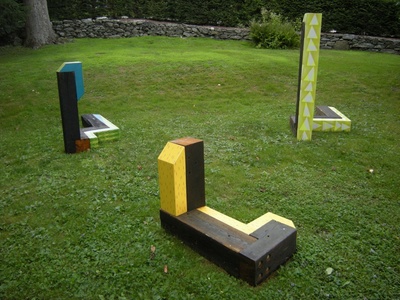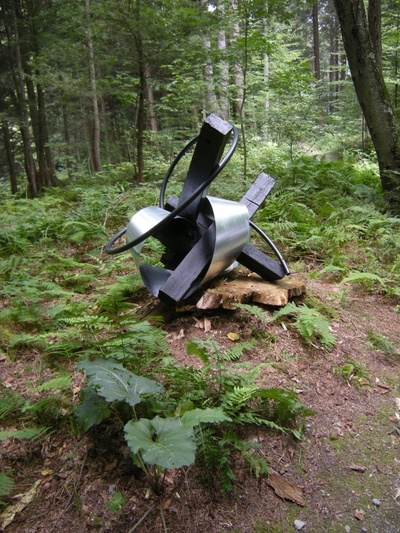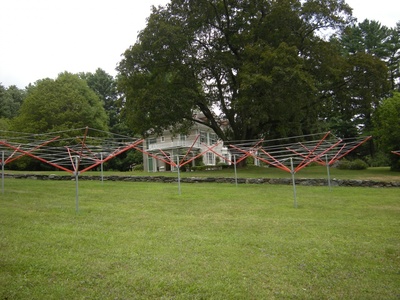Lost in the Trees: A Review of Contemporary Sculpture at Chesterwood 2012
By Stephen Vincent Kobasa

Rachel Beach, Stretch, Switch, Hatch, 2012. Painted Aluminum, Reclaimed Beams
Only some sculptures are site specific, but no sculpture is site neutral. Anywhere a work is placed transforms it, and is transformed by it. This is both the promise and the danger of a varied geography such as the one at Chesterwood that extends over several available acres of both woods and lawns. In an exhibition such as this, the matter of setting may involve even more of a curatorial obligation than the choice of the individual works. But out of the constellation of guest and resident curators complicated by artists who may or may not advocate for particular sites, it is often difficult to establish the map of responsibility for both the successes and the failures.
For example, whose thought was it to place Allen Glatter’s powdered aluminum fabrication so it registers as having been pitched into the underbrush like an abandoned bedspring? Monumental as it is, Robert Schechter’s Space Straight and Curved is located so that it gives off the aura of an abandoned shipping crate. And did anyone pause to imagine that the mowed lawn surrounding the stoneware Tea Pot Totem by Stephen Fabrico might leave it looking like a marker for Mary Poppins’ grave? This latter may not register as a failure in every quarter, of course, but if there was a choice of fairy tales, it would have been more thrilling to have the Mad Hatter evoked by the sculpture’s location.
The notion that Tim Prentice has fashioned a mechanical version of photosynthesis in his Dot Dance is not an unlikely one, especially given its placement among the branches of a pine tree. But its illusion might have been better preserved by hanging it high enough so that its structural apparatus did not become clearly visible the closer one gets to it. Kaete Brittin Shaw’s Stalactites are also hung in trees, but there is something too literal about these organic forms that renders them ordinary, placed this way. A stark architectural setting would have brought an element of surprise to the work.

Jonathan Waters, Shanghai, 2012. Wood, Pipe, Metal
Kate Kaman and Joel Erland’s Everpink with its blooming of glass fiber is so self-consciously other that it would scream itself wherever it was sited, something like those cell towers in failed arboreal disguise. Equally out of place, but in a more illuminating way, Peter Dellert’s Tree Cones dangle like a stranded alien reconnaissance craft whose occupant has wandered off in search of a device to phone home. Ursula Clark’s Sun Charm is an arbor for the apocalypse behind a fence-post boundary original to the property. It provides a coincidental evocation of ruins, with its moss-capped wood.
Jonathan Waters’ sculptures succeed in making a true theater of their surroundings with Swing like a highwayman humming a tune while waiting, and then, a few yards further on, Shanghai, as if the sphinx with its deadly riddle had found its way to the new world. Wonderful, then, to discover the more traditional depictions of that threatening mythological creature on the arms of a marble cement bench designed by Daniel Chester French in a nook elsewhere on this property where French had his summer home and studio.
Inevitably imperfect directions are posted along the route of the installation with Jamie Calderwood’s Marker the gleaming equivalent of a bad sign, Iain Machell’s Twist on Turner a guidepost as imagined by Tolkien laughing, and Austin Collins’s Fern Temple III, with its elevated scale, gesturing towards the pagan roots of Lithuanian pillar crosses placed along mountain roads. Gregory Whyte’s Acqua Twist is like a hutch for a witch’s familiar that leaves you to wonder if a small house made of bread and sugar is located nearby.

Michael Yefko, Laundry Grove, 2012. Ready-made Umbrella Clotheslines
Michael Yefko’s Laundry Grove clearly requires its site in the immediate vicinity of the grand Victorian cottage that was the French family residence. Only with that juxtaposition is the pastoral irony of its class consciousness made apparent. In this case, incongruity is almost everything. Philip Grausman’s figurative Heather stands isolated, with a surface of pure chill. A few steps away, Rachel Beach’s three constructions—Stretch/Switch/Hatch—form an ensemble of no small splendor in color and material and pattern, with each singing a different joyful song from the same hymn book.
It is difficult not to compare the series of encounters in this exhibition to another journey through the woods. Although there is no yellow brick road underfoot, one cannot help wishing that the tin here danced a little more often than it does, and that there were more threats along the way.
This exhibition is on view through October 8, 2012. 4 Williamsville Road Stockbridge, MA
www.chesterwood.org
The exhibition is guest curated by Cameron M. Shay, director, Graham Gallery, and Priscilla V. Caldwell, director, DC Moore Gallery, both New York.
Stephen Vincent Kobasa is a writer, curator and contributing editor to Art New England. His work has been published in the New Haven Independent, Big, Red and Shiny, Artes, and the Hartford Advocate.
This blog review is in honor of Judith Tolnick Champa, Editor-in-Chief of Art New England.
